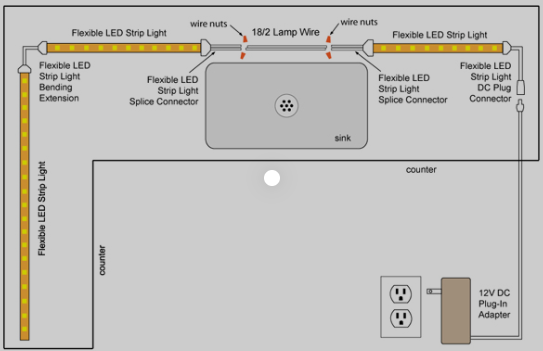LED strip lights are an excellent choice for adding color or subtlety to a room. LEDs come in large rolls that are simple to install even if you have no electrical experience. A successful installation only requires a little forethought to ensure you get the right length of LEDs and a power supply to match. The LEDs can then be connected using purchased connectors or soldered together. Although connectors are more convenient, soldering is the better option for a more permanent way to connect LED strips and connectors. Finish by adhering the LEDs to the surface with their adhesive backing and plugging them in to enjoy the ambiance they create.

Measure the space where you intend to hang the LEDs. Make an educated guess about how much LED lighting you’ll require. If you plan to install LED lighting in multiple locations, measure each one so you can cut the lighting to size later. Add the measurements together to get an idea of how much LED lighting you’ll need.
Before you do anything else, plan out the installation. Make a sketch of the area, noting where you’ll put the lights and any nearby outlets to which you can connect them.
Keep in mind the distance between the nearest outlet and the LED light location. To fill the gap, get a longer length of lighting or an extension cord.
LED strips and other supplies can be purchased online. They are also available at some department stores, home improvement stores, and light fixture retailers.
Examine the LEDs to see what voltage they require. Examine the product label on the LED strips or the website if you buy them online. LEDs can be 12V or 24V. A matching power supply is required to keep your LEDs running for an extended period of time. Otherwise, the LEDs will not be able to operate.If you intend to use multiple strips or cut LEDs into smaller strips, you can usually connect them to the same power source.
The 12V lights fit in most places and consume less power. The 24V variety, on the other hand, shines brighter and is available in longer lengths.
Determine the LED strips’ maximum power consumption. Each LED light strip uses a certain amount of wattage, also known as electrical power. It is determined by the length of the strip. Check the product label to see how many watts are used per 1 ft (0.30 m) of lighting. Then, multiply the watts by the total length of the strip you intend to install.
To determine the minimum power rating, multiply the power consumption by 1.2. The outcome will indicate how powerful your power supply must be in order to keep the LEDs powered. Because LEDs may consume slightly more power than expected, add 20% to the total and consider it your minimum. As a result, the available power will never fall below what the LEDs require.
To calculate the minimum amperes, divide the power consumption by the voltage. One more measurement is required before you can power up your new LED strips. Amperes, or amps, are units of measurement for how fast an electrical current travels. If the current cannot move quickly enough through a long stretch of LED strips, the lights will dim or turn off. The amp rating can be measured using a multimeter or estimated using simple math.
Purchase a power supply that meets your power needs. You now have enough information to choose the best power supply for the LEDs. Find a power supply that matches the maximum power rating in watts as well as the amperage you calculated earlier. A brick-style adapter, similar to those used to power laptops, is the most common type of power supply. It’s extremely simple to use because all you have to do is plug it into the wall after connecting it to the LED strip. Most modern adapters include the components required to connect them to LED strips.
Post time: Jan-06-2023

 Chinese
Chinese